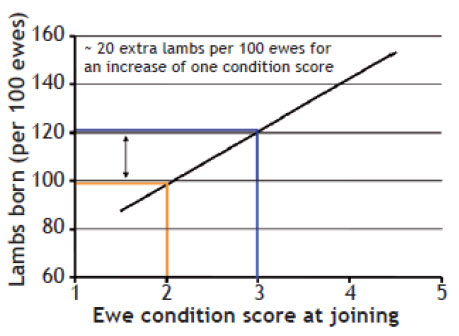Timing of joining
Management of successful joining starts from the previous weaning period, for both ewes and rams. This is because after weaning, ewes need to eat and regain body condition prior to mating. The most reliable strategy for weaning the maximum number of good quality lambs is to ensure most ewes get pregnant in the shortest joining period possible.
Diagram 1 shows the importance of ewe body condition score on the fecundancy of ewe (click for further information)
The relationship between ewe condition score and the number of lambs conceived

Diagram 1 - Lambs born per 100 ewes is determined by BCS at joining (Source: Lifetime Ewe, AWI)
Oestrus activity in ewes increases after the longest day (22 December) and as day length shortens, melatonin production in the brain stimulates cycling activity, which increases to a peak between March and May (when most ewes are cycling with higher ovulation rates). Cycling in Merinos and Dorpers is least affected by day length, however breeds such as Border Leicesters, Coopworths and Romneys are most affected by day length. This effect is graphically demonstrated in diagram 2.
Effect of Day Length on Ewe Oestrus Cycle
Diagram 2 - A graphical representation of Daylight or Melatonin levels on Ewe Cycling
| Reproductive Cycle of Ewes |
| Stage |
Average |
|
Range |
| Puberty age |
5 to 12 Months |
| Oestrus cycle |
17 days |
|
13-19 days |
| Oestrus duration |
30 days |
|
18-48 days |
| Ovulation release |
20-30 hours after start of Oestrus |
| Gestation |
146 days |
|
135-150 days |
Table 1 - Variation in Ewe Reproductive Cycle